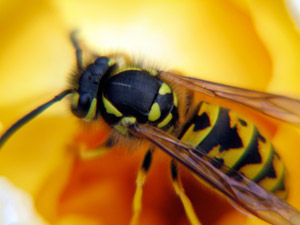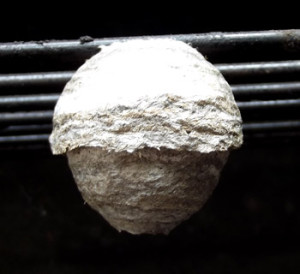All (Wasp) Flights Cancelled!
By Chris Williams on January 29, 2015.

Photo credit: audreyjm529 / Foter / CC BY
Winter comes fast in the Northeastern United States, as we all learned on Tuesday. After a relatively mild winter, New England was hit with a huge blizzard earlier this week that put the region, and all its insect inhabitants, into a deep freeze.
Every winter, blasts of Arctic air flow down over the Northeast relentlessly starting in late October and November, putting an end to most wasp flights outside structures. Some activity may be noticed outside during intermittent warm spells, usually around south facing eaves and soffits in the late afternoon.
All wasp species, and insects for that matter, are what we call “cold blooded” or Poikilothermic animals, which means they rely on the surrounding temperature conditions to warm or cool their bodies. As temperatures decrease, most insects become less able to move about. Wasps, ladybugs, boxelder bugs, shield or skink bugs, and spiders may invade homes as temperatures decline.
In the Northeastern United States, paper wasp activity generally declines during the winter months. However, two groups of wasps seem to be more bothersome during fall and winter months: paper wasps of the family Vespidae, stinging insects including our Yellow Jackets and Bald-faced Hornets (Vespinae); and the umbrella or tea cup wasps (Polistinae).
Our most common polistes wasps, the European Banded paper wasp (yellow and black striped with orange or yellow legs, small nest of up to 30 individuals, situated under an overhang, chair, deck rail, grill, rake boards, and inside soffits) and the Northern paper wasp (long brown wasp, relatively slow moving, long legs for walking on plants, nests similar to EBPW, nests may be larger in some locations.) Both species will fly out and defend their nest if disturbed but not as vigorously as Vespinae. These similar species are predators, capturing prey and feeding their larvae at the nest site.
Overwintering reproductives and workers may survive on or near protected nest sites within structures, and occasionally find their way into living spaces via air currents, recessed lights, ductwork, or paneling. Warming void spaces on hot afternoons may stimulate activity and produce wasps at sunny windows and lights. Although non-aggressive at this time, stinging may occur if handled, entangled, or sat upon. These sluggish wasps can be easily crushed and placed in a rubbish container without incident. In some cases, sealing off cracks and other possible entry points as you would to reduce drafts can be very effective in limiting this type of activity.
Yellow Jacket Life Cycle

Photo by Tim Chase
Yellow Jackets are by far the most troubling wasps during late summer and fall. A brief overview of the lifecycle will aid in understanding what takes place as yellow jacket nests decline. A yellow jacket nest begins when an overwintering queen, having been fertilized the previous fall, awakens from hibernation and builds the proto-nest. She seeks out just the right place to build a paper nest (in wall voids, soffits, under decks and rooflines, in bushes, in mouse holes, etc.). Over time the nest is constructed by workers, who continue to forage and gather nest material. By mid-July, the nest is of substantial size with production in full swing. The nest will be very busy this time of year and may be noticed, and eliminated. The Queen yellow jacket lays eggs in the brood cells created by the workers. These cells are made of the same paper nesting material (wood and saliva) as the outer shell of the paper nest. Workers bring food and nest material back to the nest throughout the day; outside work largely stops after dusk, as wasps are visual fliers and rely on the sun and other visual cues to navigate.
The worm-like yellow jacket larvae are ravenous and consume whatever is brought to them, mostly insect parts, fruit pulp, and honeydew. After a week or two, the larvae spin a cover over their cell which begins their transformation into the adult wasp. Early in the season, all larvae become workers, but as the days grow shorter queens and males are produced in increasing numbers. The last larvae to pupate will be the largest of the queens produced, who, if all goes as planned, will mate and overwinter, forming a new nest next year.
Once outside temperatures fall below levels that allow for active flights, all wasp flights are cancelled! Overwintering queens and workers that pupate after temperatures drop below freezing may survive for a short time after hatching and invade living spaces. This activity will subside!
Even in these cold and snowy weeks ahead, any sign of pest activity including noises in the wall (from mice or wildlife), numerous insects of any kind in your house, as well as sawdust, or soil/staining in any location may be of concern.